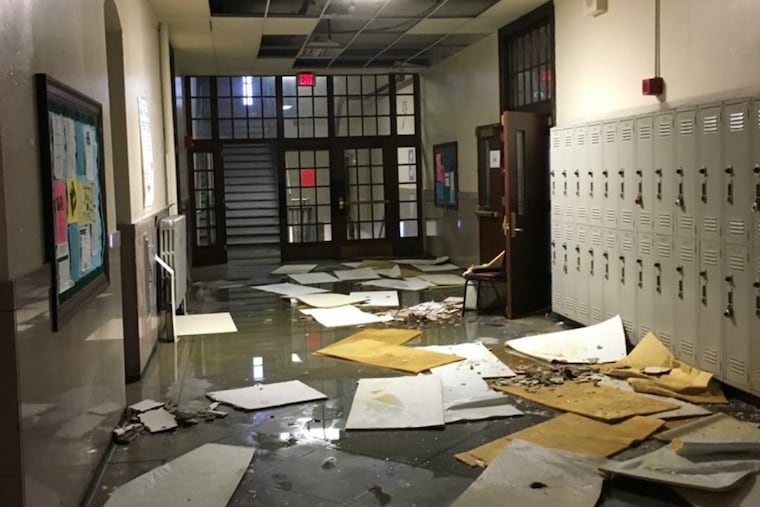Philly schools are falling apart, and taking students’ self-esteem down with them | Opinion
Kids are perceptive. They know what schools should and can look like, and they know they don't have them

To know what the Academy at Palumbo is, you have to know how the kids talk about the Academy at Palumbo.
I've worked there, and I've worked with kids who wanted to go there, and I've seen the high quality of education that the school provides. It's the kind of school that Philadelphia's middle schoolers hope to get into, and that they don't want to talk about too loudly as not to jinx it. To get in is not only to symbolize your achievement — it's to keep your head above water in a school district that chews students up and spits them out. It's a chance.
Earlier this month, Palumbo, where I worked as a substitute teacher last year, was flooded after heavy rain. The photos and videos are brutal; The ceiling was entirely underwater, and debris was floating across the floors as if it were monsoon season in Thailand. School was dismissed early. But if you had read Palumbo's school maintenance report, which ranked Palumbo very highly, you'd have thought the building was in pristine condition.
>> READ MORE: Days of rain cause major flooding, ceiling collapse at a S. Philly HS
Now, there's a lot to say about a building condition system that rates a school that can't sustain a few days of wetness roughly as an 89 out of 100. Philly's neighborhood schools are falling apart, as they are, on average, 66 years old, and the situation is an infrastructure disaster.
We're hurtling into a climatically absurd 21st century with our kids placed in aging fortresses that are not ready to match a hotter, wetter, and generally crappier future. The hallways are jungles, the floors are swamps, and fixing these schools would cost a jaw-dropping amount of money — if many of them weren't just destined to be shut down to make way for upscale condos.
It's not just a local crisis, it's a national one; according to the American Society of Civil Engineers, the 2008 recession has led to a massive crunch in the capital funds that sustain school repairs, and thus to "accelerating deterioration of heating, cooling, and lighting systems." As of last year, it was estimated that it would take at least $4.5 billion to make sufficient repairs to Philly schools.
That's before one of South Philly's marquee educational facilities flooded and schools across town had to dismiss early for almost an entire week because it was too hot and the schools don't have adequate climate control.
But that grim and seemingly inescapable cataclysm, while predestined, isn't what sits on the shoulders of Philadelphia's students right now.
They're not scared that Palumbo or Furness might shut down some time in the deep, dark future. They're brought down by the painful environments in which they have to try to learn. Studies have repeatedly proven that academic achievement is negatively affected when schools are in disrepair.
Such is the life of many a middle schooler in South Philadelphia. They bust their humps to get into Palumbo, only to see it flood with rain water, drop ceilings sliding down the hallway. In some schools, they see massive black roaches. In others, the students sulk through the halls in absurd humidity in late August and hear the mice scurry around as the class silently does a test.
I've worked in Philadelphia and Camden schools for about a year now, first as a substitute and now as a teacher, and I've learned to redefine what a hostile learning environment is.
It's not just bullies and uptight teachers and rampant testing. It's the perceived reality of your relative worth in the educational system. It's waking up every morning knowing that your school has less, and will never have more, and that the poverty you experience at home will be mirrored at school.
Students are perceptive. It's not as if they don't have benchmarks for what good schools look like. They have cousins in the suburbs. They watch shows about their contemporaries on TV. They know what schools should and can look like, and they know they don't have them — and that they have less and less of them every year.
There's a lot of discussion around self-stereotyping in education, and its incredible corrosiveness. Every teacher in Philadelphia and Camden has had a student who, at some juncture, has said, "I can't, because I was born into this and it's destiny." It's obviously wrong, and a painful thing to hear, but if the school of your dreams floods, or has hallways too hot to inhabit, it becomes infinitely more difficult to fight back against the notion.
Want kids to invest in their own education? Invest in them. And not in laptop carts or iPads. Invest in dry floors and AC units and capable custodial and maintenance crews. Make students know they matter and they're worth it.
Quinn O'Callaghan is a teacher and freelance writer. His books are represented by Dystel, Goderich and Bourret Literary.